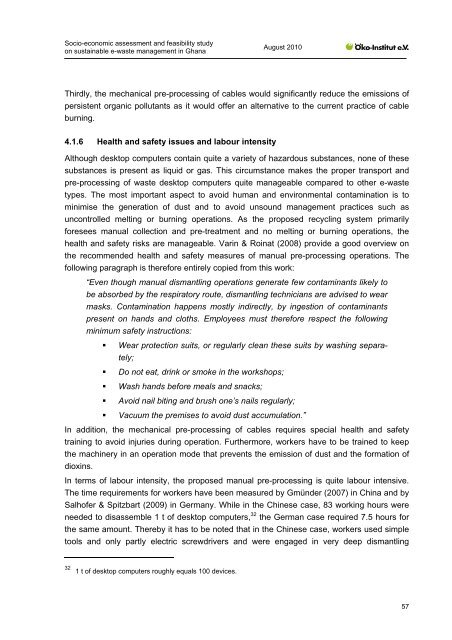Socio-economic assessment and feasibility study on - Öko-Institut eV
Socio-economic assessment and feasibility study on - Öko-Institut eV
Socio-economic assessment and feasibility study on - Öko-Institut eV
Create successful ePaper yourself
Turn your PDF publications into a flip-book with our unique Google optimized e-Paper software.
<str<strong>on</strong>g>Socio</str<strong>on</strong>g>-<str<strong>on</strong>g>ec<strong>on</strong>omic</str<strong>on</strong>g> <str<strong>on</strong>g>assessment</str<strong>on</strong>g> <str<strong>on</strong>g>and</str<strong>on</strong>g> <str<strong>on</strong>g>feasibility</str<strong>on</strong>g> <str<strong>on</strong>g>study</str<strong>on</strong>g><br />
<strong>on</strong> sustainable e-waste management in Ghana<br />
August 2010<br />
Thirdly, the mechanical pre-processing of cables would significantly reduce the emissi<strong>on</strong>s of<br />
persistent organic pollutants as it would offer an alternative to the current practice of cable<br />
burning.<br />
4.1.6 Health <str<strong>on</strong>g>and</str<strong>on</strong>g> safety issues <str<strong>on</strong>g>and</str<strong>on</strong>g> labour intensity<br />
Although desktop computers c<strong>on</strong>tain quite a variety of hazardous substances, n<strong>on</strong>e of these<br />
substances is present as liquid or gas. This circumstance makes the proper transport <str<strong>on</strong>g>and</str<strong>on</strong>g><br />
pre-processing of waste desktop computers quite manageable compared to other e-waste<br />
types. The most important aspect to avoid human <str<strong>on</strong>g>and</str<strong>on</strong>g> envir<strong>on</strong>mental c<strong>on</strong>taminati<strong>on</strong> is to<br />
minimise the generati<strong>on</strong> of dust <str<strong>on</strong>g>and</str<strong>on</strong>g> to avoid unsound management practices such as<br />
unc<strong>on</strong>trolled melting or burning operati<strong>on</strong>s. As the proposed recycling system primarily<br />
foresees manual collecti<strong>on</strong> <str<strong>on</strong>g>and</str<strong>on</strong>g> pre-treatment <str<strong>on</strong>g>and</str<strong>on</strong>g> no melting or burning operati<strong>on</strong>s, the<br />
health <str<strong>on</strong>g>and</str<strong>on</strong>g> safety risks are manageable. Varin & Roinat (2008) provide a good overview <strong>on</strong><br />
the recommended health <str<strong>on</strong>g>and</str<strong>on</strong>g> safety measures of manual pre-processing operati<strong>on</strong>s. The<br />
following paragraph is therefore entirely copied from this work:<br />
“Even though manual dismantling operati<strong>on</strong>s generate few c<strong>on</strong>taminants likely to<br />
be absorbed by the respiratory route, dismantling technicians are advised to wear<br />
masks. C<strong>on</strong>taminati<strong>on</strong> happens mostly indirectly, by ingesti<strong>on</strong> of c<strong>on</strong>taminants<br />
present <strong>on</strong> h<str<strong>on</strong>g>and</str<strong>on</strong>g>s <str<strong>on</strong>g>and</str<strong>on</strong>g> cloths. Employees must therefore respect the following<br />
minimum safety instructi<strong>on</strong>s:<br />
� Wear protecti<strong>on</strong> suits, or regularly clean these suits by washing separately;<br />
� Do not eat, drink or smoke in the workshops;<br />
� Wash h<str<strong>on</strong>g>and</str<strong>on</strong>g>s before meals <str<strong>on</strong>g>and</str<strong>on</strong>g> snacks;<br />
� Avoid nail biting <str<strong>on</strong>g>and</str<strong>on</strong>g> brush <strong>on</strong>e’s nails regularly;<br />
� Vacuum the premises to avoid dust accumulati<strong>on</strong>.”<br />
In additi<strong>on</strong>, the mechanical pre-processing of cables requires special health <str<strong>on</strong>g>and</str<strong>on</strong>g> safety<br />
training to avoid injuries during operati<strong>on</strong>. Furthermore, workers have to be trained to keep<br />
the machinery in an operati<strong>on</strong> mode that prevents the emissi<strong>on</strong> of dust <str<strong>on</strong>g>and</str<strong>on</strong>g> the formati<strong>on</strong> of<br />
dioxins.<br />
In terms of labour intensity, the proposed manual pre-processing is quite labour intensive.<br />
The time requirements for workers have been measured by Gmünder (2007) in China <str<strong>on</strong>g>and</str<strong>on</strong>g> by<br />
Salhofer & Spitzbart (2009) in Germany. While in the Chinese case, 83 working hours were<br />
needed to disassemble 1 t of desktop computers, 32 the German case required 7.5 hours for<br />
the same amount. Thereby it has to be noted that in the Chinese case, workers used simple<br />
tools <str<strong>on</strong>g>and</str<strong>on</strong>g> <strong>on</strong>ly partly electric screwdrivers <str<strong>on</strong>g>and</str<strong>on</strong>g> were engaged in very deep dismantling<br />
32 1 t of desktop computers roughly equals 100 devices.<br />
57

















